2017 LEXUS RC300H flat tire
[x] Cancel search: flat tirePage 564 of 640
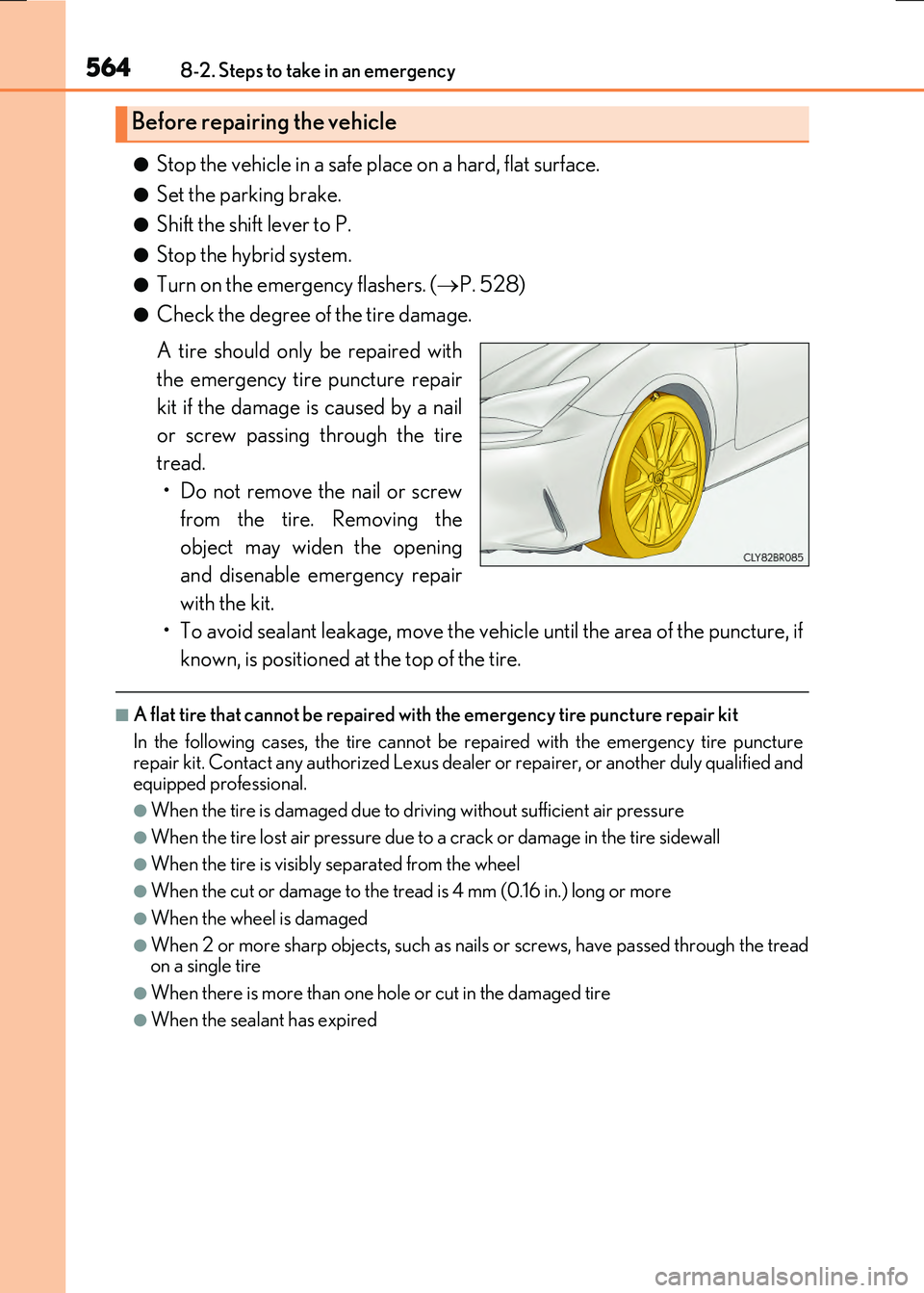
5648-2. Steps to take in an emergency
RC300h_EE(OM24740E)
●Stop the vehicle in a safe place on a hard, flat surface.
●Set the parking brake.
●Shift the shift lever to P.
●Stop the hybrid system.
●Turn on the emergency flashers. (P. 528)
●Check the degree of the tire damage.
A tire should only be repaired with
the emergency tire puncture repair
kit if the damage is caused by a nail
or screw passing through the tire
tread.
• Do not remove the nail or screw
from the tire. Removing the
object may widen the opening
and disenable emergency repair
with the kit.
• To avoid sealant leakage, move the vehicle until the area of the puncture, if
known, is positioned at the top of the tire.
■A flat tire that cannot be repaired with the emergency tire puncture repair kit
In the following cases, the tire cannot be repaired with the emergency tire puncture
repair kit. Contact any authorized Lexus dealer or repairer, or another duly qualified and equipped professional.
●When the tire is damaged due to driving without sufficient air pressure
●When the tire lost air pressure due to a crack or damage in the tire sidewall
●When the tire is visibly separated from the wheel
●When the cut or damage to the tread is 4 mm (0.16 in.) long or more
●When the wheel is damaged
●When 2 or more sharp objects, such as nails or screws, have passed through the tread on a single tire
●When there is more than one hole or cut in the damaged tire
●When the sealant has expired
Before repairing the vehicle
Page 569 of 640
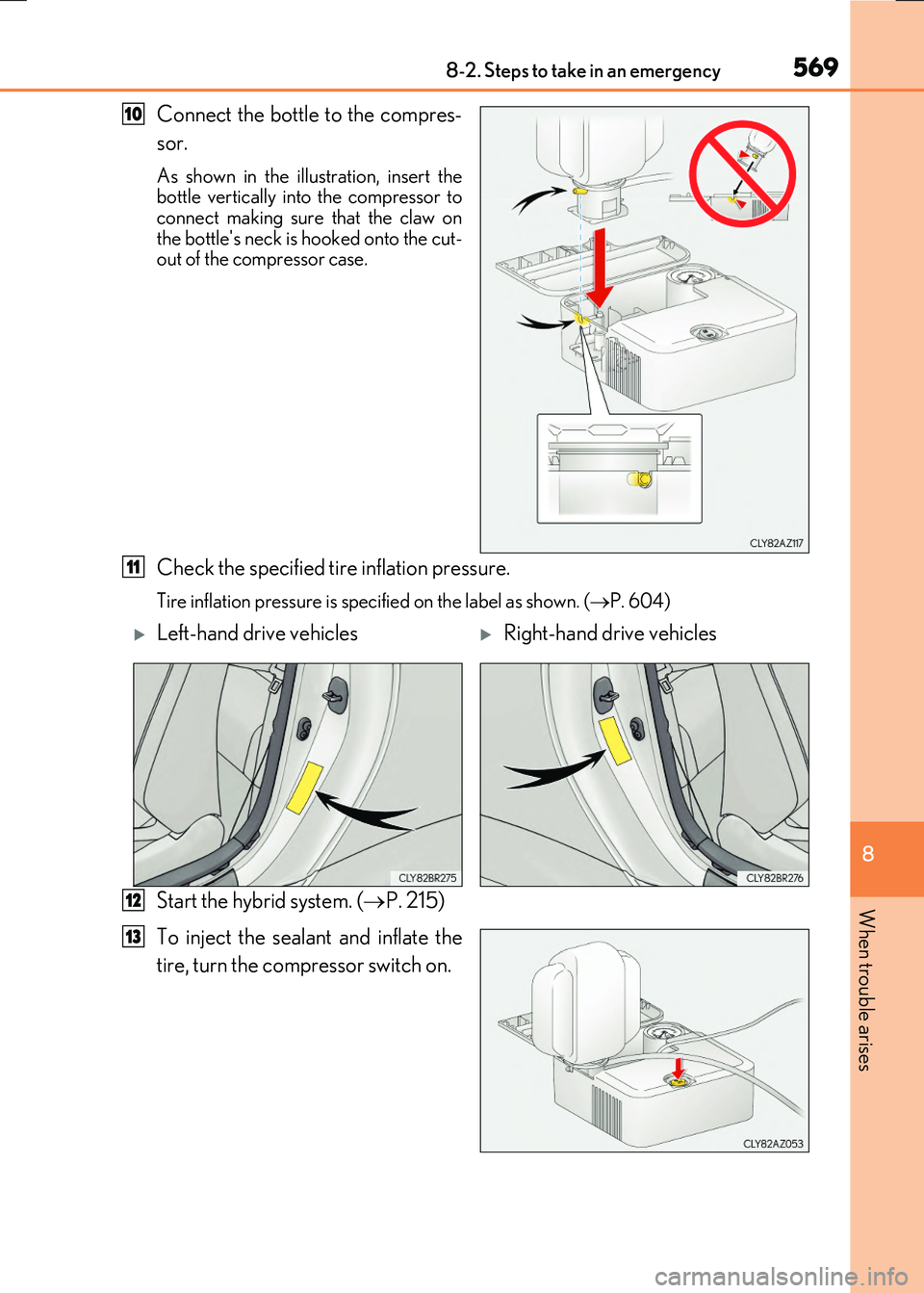
5698-2. Steps to take in an emergency
8
When trouble arises
RC300h_EE(OM24740E)
Connect the bottle to the compres-
sor.
As shown in the illustration, insert the bottle vertically into the compressor toconnect making sure that the claw on
the bottle's neck is hooked onto the cut- out of the compressor case.
Check the specified tire inflation pressure.
Tire inflation pressure is spec ified on the label as shown. (P. 604)
Start the hybrid system. (P. 215)
To inject the sealant and inflate the
tire, turn the compressor switch on.
10
11
Left-hand drive vehiclesRight-hand drive vehicles
12
13
Page 570 of 640

5708-2. Steps to take in an emergency
RC300h_EE(OM24740E)
Inflate the tire until the specified air
pressure is reached.
The sealant will be injected and the
pressure will surge and then gradu-
ally decrease.
The air pressure gauge will display
the actual tire inflation pressure
about 1 minute (5 minutes at low
temperature) after the switch is
turned on.
Inflate the tire until the specified air
pressure.
• Turn the compressor switch off and
then check the tire inflation pressure.
Being careful not to over inflate,
check and repeat the inflation pro-
cedure until the specified tire infla-
tion pressure is reached.
• If the tire inflation pressure is still lower than the specified point after inflation
for 35 minutes with the switch on, the ti re is too damaged to be repaired. Turn
the compressor switch off and contact any authorized Lexus dealer or
repairer, or another duly qualified and equipped professional.
• If the tire inflation pressure exceeds th e specified air pressure, let out some air
to adjust the tire inflation pressure. ( P. 573, 604)
With the compressor switch off, disconne ct the hose from the valve on the tire
and then pull out the power plug from the power outlet socket.
Some sealant may leak wh en the hose is removed.
Install the valve cap onto the valve of the emergency repaired tire.
Attach the air release cap to the end
of the hose.
If the air release cap is not attached, the sealant may leak and the vehicle may
get dirty.
14
1
2
3
15
16
17
Page 571 of 640
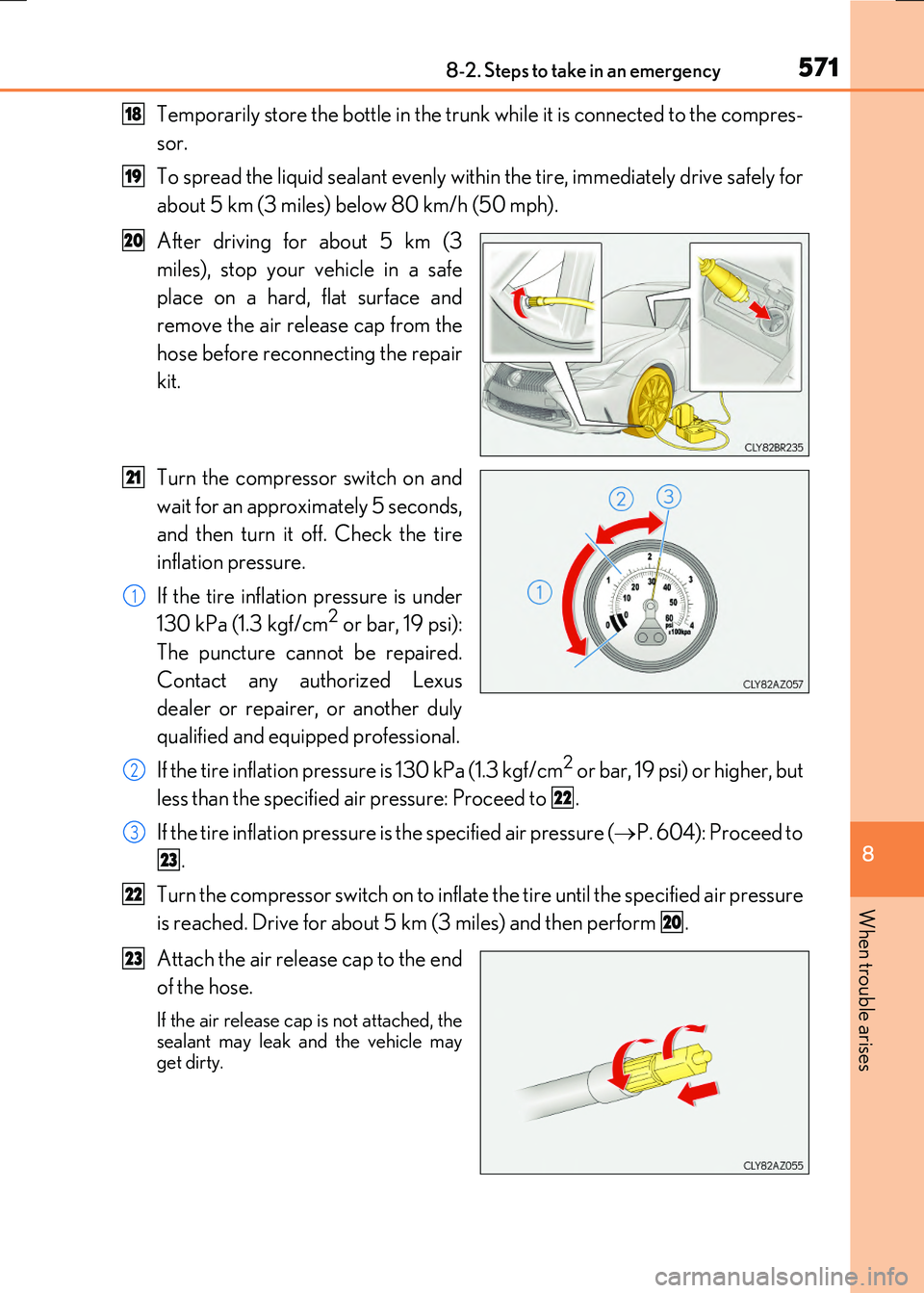
5718-2. Steps to take in an emergency
8
When trouble arises
RC300h_EE(OM24740E)
Temporarily store the bottle in the trunk while it is connected to the compres-
sor.
To spread the liquid sealant evenly within the tire, immediately drive safely for
about 5 km (3 miles) below 80 km/h (50 mph).
After driving for about 5 km (3
miles), stop your vehicle in a safe
place on a hard, flat surface and
remove the air release cap from the
hose before reconnecting the repair
kit.
Turn the compressor switch on and
wait for an approximately 5 seconds,
and then turn it off. Check the tire
inflation pressure.
If the tire inflation pressure is under
130 kPa (1.3 kgf/cm
2 or bar, 19 psi):
The puncture cannot be repaired.
Contact any authorized Lexus
dealer or repairer, or another duly
qualified and equipped professional.
If the tire inflation pressure is 130 kPa (1.3 kgf/cm
2 or bar, 19 psi) or higher, but
less than the specified air pressure: Proceed to .
If the tire inflation pressure is the specified air pressure ( P. 604): Proceed to
.
Turn the compressor switch on to inflate the tire until the specified air pressure
is reached. Drive for about 5 km (3 miles) and then perform .
Attach the air release cap to the end
of the hose.
If the air release cap is not attached, the
sealant may leak and the vehicle may
get dirty.
18
19
20
21
1
2
22
3
23
22
20
23
Page 573 of 640
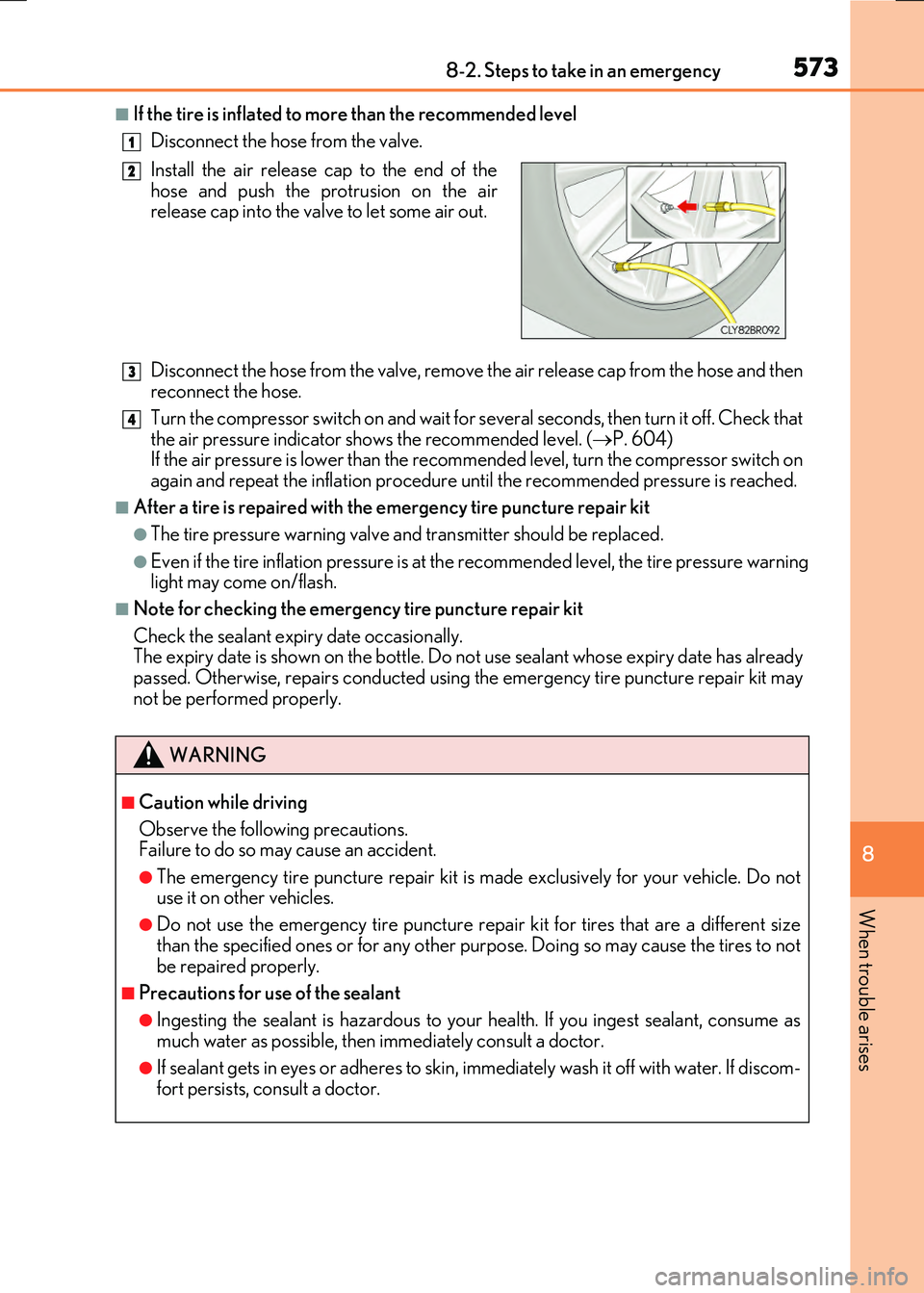
5738-2. Steps to take in an emergency
8
When trouble arises
RC300h_EE(OM24740E)
■If the tire is inflated to more than the recommended level
Disconnect the hose from the valve.
Disconnect the hose from the valve, remove the air release cap from the hose and then reconnect the hose.
Turn the compressor switch on and wait for several seconds, then turn it off. Check that the air pressure indicator sh ows the recommended level. (P. 604) If the air pressure is lower than the reco mmended level, turn the compressor switch on
again and repeat the inflation procedure un til the recommended pressure is reached.
■After a tire is repaired with the emergency tire puncture repair kit
●The tire pressure warning valve and transmitter should be replaced.
●Even if the tire inflation pressure is at the recommended level, the tire pressure warning light may come on/flash.
■Note for checking the emergency tire puncture repair kit
Check the sealant expiry date occasionally. The expiry date is shown on the bottle. Do not use sealant whose expiry date has alreadypassed. Otherwise, repairs conducted using th e emergency tire puncture repair kit may
not be performed properly.
Install the air release cap to the end of the hose and push the protrusion on the airrelease cap into the valve to let some air out.
WARNING
■Caution while driving
Observe the following precautions. Failure to do so may cause an accident.
●The emergency tire puncture repair kit is made exclusively for your vehicle. Do notuse it on other vehicles.
●Do not use the emergency tire puncture repa ir kit for tires that are a different size
than the specified ones or fo r any other purpose. Doing so may cause the tires to not be repaired properly.
■Precautions for use of the sealant
●Ingesting the sealant is hazardous to your health. If you ingest sealant, consume asmuch water as possible, then immediately consult a doctor.
●If sealant gets in eyes or adheres to skin, immediately wash it off with water. If discom-
fort persists, consult a doctor.
1
2
3
4
Page 574 of 640

5748-2. Steps to take in an emergency
RC300h_EE(OM24740E)
WARNING
■When fixing the flat tire
Observe the following precautions. Failure to do so may result in death or serious injury.
●Stop your vehicle in a safe and flat area.
●Do not touch the wheels or the area around the brakes immediately after the vehicle has been driven.
After the vehicle has been driven, the wheels and the area around the brakes may be extremely hot. Touching these areas with hands, feet or other body parts may result inburns.
●Connect the valve and hose securely with the tire installed on the vehicle.
• If the hose is not properly connected to the valve, air leakage may occur or sealant may be sprayed out.
• If the hose comes off the valve while inflating the tire, there is a risk that the hose will move abruptly due to air pressure.• After inflation of the tire has completed, the sealant may splatter when the hose is
disconnected or some air is let out of the tire.
●Follow the operation procedure to repair the tire. If the procedure is not followed, the
sealant may spray out.
●Keep back from the tire while it is being repaired, as there is a chance of it bursting while the repair operation is being performe d. If you notice any cracks or deforma-
tion of the tire, turn off the compressor sw itch and stop the repair operation immedi- ately.
●The kit may overheat if operated for a long period of time. Do not operate the com-
pressor continuously for more than 35 minutes.
●Parts of the kit become hot during operatio n. Be careful handling the kit during and after operation. Do not touch the metal part around the connecting area between the
bottle and compressor. It will be extremely hot.
●Do not attach the vehicle speed warning sticker to an area other than the one indi- cated. If the sticker is attached to an area where an SRS airbag is located, such as the
pad of the steering wheel, it may preven t the SRS airbag from operating properly.
■Driving to spread the liquid sealant evenly
●Drive the vehicle carefully at a low speed. Be especially careful when turning and cor-
nering.
●If the vehicle does not drive straight or you feel a pull through the steering wheel, stop the vehicle and check the following:
• Tire condition. The tire may have separated from the wheel. • Tire inflation pressure. If tire inflation pressure is 130 kPa (1.3 kgf/cm2 or b ar, 1 9 p si)or below, this may indica te severe tire damage.
Page 604 of 640

6049-1. Specifications
RC300h_EE(OM24740E)
17-inch tires
18-inch tires
19-inch tires
Steering
Free playLess than 30 mm (1.2 in.)
Tires and wheels
Tire size225/50R17 94W
Tire inflation pressure (Recommended cold
tire inflation pressure)
Vehicle speedFront wheel kPa (kgf/cm2 orbar, psi)
Rear wheelkPa (kgf/cm2 orbar, psi)
More than 190 km/h
(118 mph)270 (2.7, 39)270 (2.7, 39)
190 km/h (118 mph) or less240 (2.4, 35)240 (2.4, 35)
Wheel size17 7 1/2J
Wheel nut torque103 N•m (10.5 kgf•m, 76 ft•lbf)
Tire size235/45R18 94Y
Tire inflation pressure (Recommended cold
tire inflation pressure)
Front wheel kPa (kgf/cm2 or bar, psi)Rear wheelkPa (kgf/cm2 or bar, psi)
240 (2.4, 35)240 (2.4, 35)
Wheel size18 8J
Wheel nut torque103 N•m (10.5 kgf•m, 76 ft•lbf)
Tire size235/40R19 96Y XL, 265/35R19 94Y
Tire inflation pressure (Recommended coldtire inflation pressure)
Front wheel
kPa (kgf/cm2 or bar, psi)
Rear wheel
kPa (kgf/cm2 or bar, psi)
240 (2.4, 35)250 (2.5, 36)
Wheel size19 8J (235/40R19), 19 9J (265/35R19)
Wheel nut torque103 N•m (10.5 kgf•m, 76 ft•lbf)
Page 617 of 640
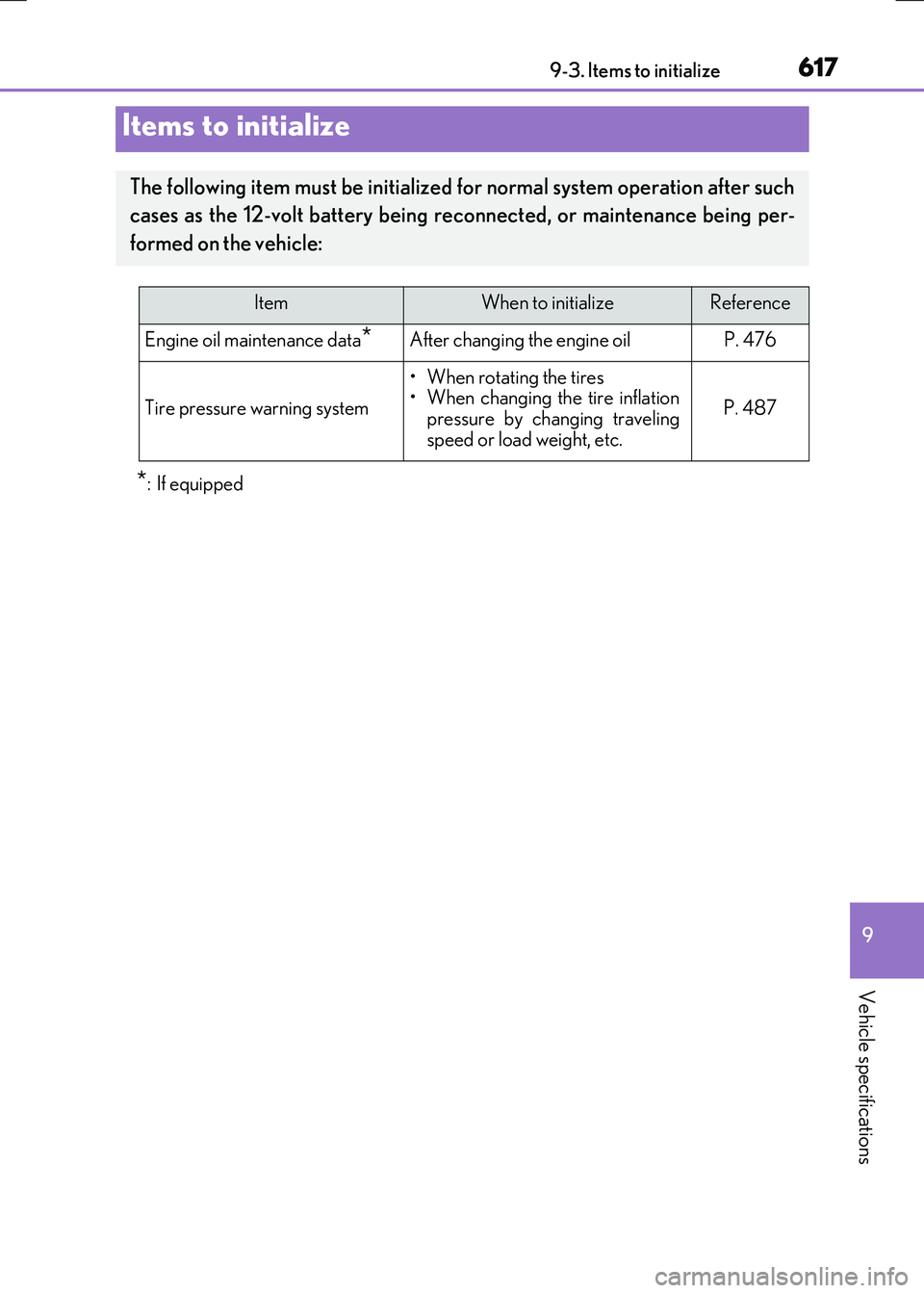
617
RC300h_EE(OM24740E)
9
Vehicle specifications
9-3. Items to initialize
*: If equipped
Items to initialize
The following item must be initialized for normal system operation after such
cases as the 12-volt battery being re connected, or maintenance being per-
formed on the vehicle:
ItemWhen to initializeReference
Engine oil maintenance data*After changing the engine oilP. 476
Tire pressure warning system
• When rotating the tires • When changing the tire inflation
pressure by changing traveling speed or load weight, etc.
P. 487